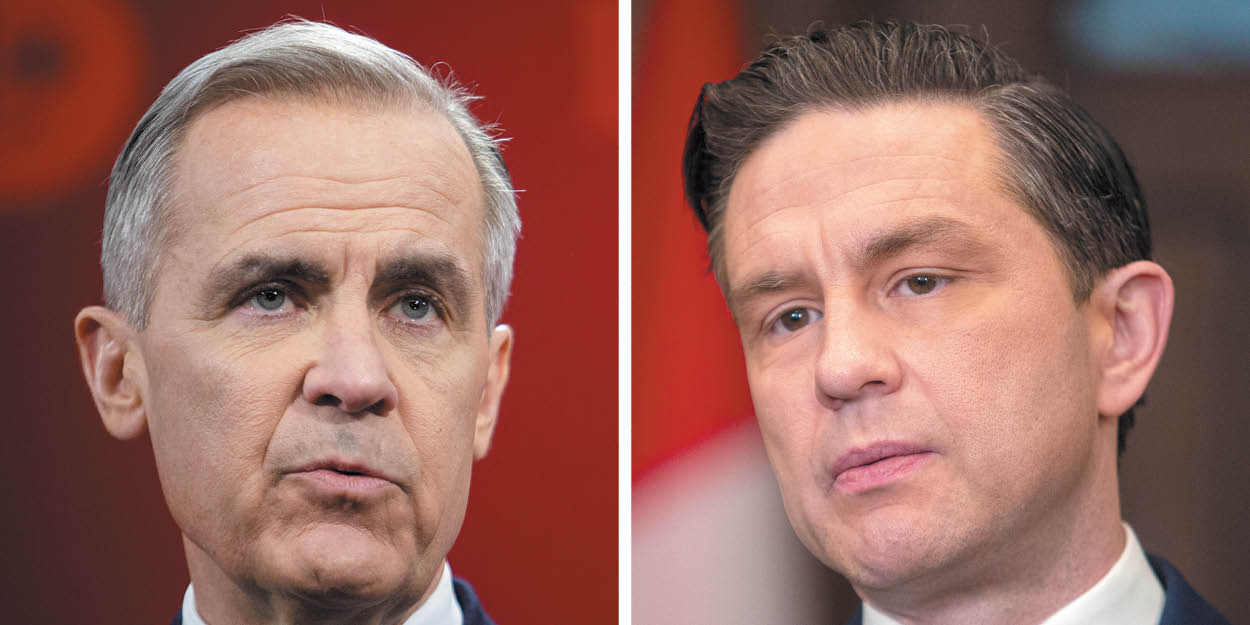‘If you’ve got the money, spend it’: three major parties boost digital ad buys to define Prime Minister Carney’s brand

Newly minted Prime Minister Mark Carney’s campaign for Liberal leadership spent just shy of $300,000 on Facebook and Instagram ads to introduce him to the party membership. Yet, while that investment is already providing dividends amongst the general public, the Conservatives and NDP have begun boosting their spending to ensure Carney is defined on their terms.
In the final two weeks of the Liberal leadership contest—Feb. 24 through March 9—Carney spent just shy of $150,000 on Meta ads alone, dwarfing the combined spend of his three remaining rivals as well as the combined spend on the official pages of both then-prime minister Justin Trudeau (Papineau, Que.) and the Liberal Party.
Those final two weeks also represent more than half of Carney’s entire Meta advertising spend—just over $290,000—with the penultimate week, Feb. 3 through Marcunh 2, representing roughly one-third. This is in addition to the week leading up to the membership registration deadline, Jan. 20-26, when his campaign spent more than $117,000 on Meta ads. During the interim, his campaign’s Meta spending fluctuated between roughly $2,100 and $9,900. In the week following his leadership win, the spending has dropped back down to roughly $8,500.
Online political marketing expert Harneet Singh told The Hill Times that despite cementing his front-runner status early on in the campaign across nearly every metric—advertising budget, fundraising, and polling—every dollar spent was a meaningful investment, for which Carney may not have yet reaped the full benefits.
“Spending all of that money just signals confidence in the campaign, and that will absolutely translate to a national campaign,” explained Singh, a managing principal at EOK Consults.
Singh also noted that while Carney’s total spending on Meta may seem high compared to his leadership rivals—who spent a combined $62,116 between the other four people who were official candidates at any point during the race—the total becomes quite conservative compared to his fundraising numbers.
According to the publicly available interim reports published by Elections Canada, Carney’s campaign raised more than $3.3-million between Jan. 10 and March 2. However, as of the leadership vote on March 9, his campaign said it had raised more than $5-million.

Based on the publicly available data, Carney’s Meta spending translates to roughly 8.6 per cent of the campaign’s fundraising, but drops to just less than six per cent based on the campaign’s updated total.
New Transport and Internal Trade Minister Chrystia Freeland (University Rosedale, Ont.), who placed second in the leadership contest, raised $361,398 according to Elections Canada, and spent $12,406 on Meta ads—roughly 3.4 per cent. MP Karina Gould (Burlington, Ont.), the contest’s second runner-up, spent $9,562 of the $363,149 her campaign raised, or 2.63 per cent. However, both campaigns have also said those fundraising numbers do not accurately reflect their respective totals. According to The Canadian Press, Freeland’s team internally reported $750,000, and Gould’s team said it raised $450,000. Accounting for those internal totals, the campaigns’ Meta spending drops to 1.65 per cent and 2.73 per cent of their fundraising, respectively.
Singh also noted that based on the total number of votes, he would have given an “arm and a leg” for similar efficiency on campaigns he has previously worked on.
Excluding Nunavut, where his campaign spent roughly $8 on Meta ads for each of the 25 votes he received in the territory, Carney’s least efficient provinces were Quebec and Saskatchewan, where his campaign spent $6.35 and $5.03 per vote, respectively. Carney’s most efficient province was Ontario, where his campaign spent $1.45 per vote received.
“I absolutely believe this was a good investment, and at no point do I believe they were solely focused on the leadership race,” Singh said, explaining that every voter identified during the leadership race would pay dividends in the general election.
“The intent was to ensure Carney became a household name in Canada,” Singh said, adding that market research on Meta has found that each dollar spent translates to roughly 20-30 people who will see it.
“Conservatively, spending that much money means that nearly six million more Canadians know about him today than before,” Singh explained, noting that Carney’s official Facebook page had grown from just over 1,000 followers at the beginning of the race to more than 95,000 as of publication deadline. In comparison, Trudeau’s page has 8.8 million, followed by Conservative Leader Pierre Poilievre’s (Carleton, Ont.) with 828,600, and NDP Leader Jagmeet Singh’s (Burnaby South, B.C.), with over 397,600 followers.
Conservative digital ad strategist Cole Hogan agreed that Carney’s digital investment will serve him well in a general election, noting that the prime minister can now combine any data scraped from the ads with that collected from phone banking and door-knocking, as well as the party’s pre-existing database.

“This was a two-month campaign where [Carney] had to be everywhere but couldn’t physically be there,” Hogan said, noting that in most campaigns—but especially leadership races—”the candidate who spends the most money usually wins.”
While his spending advantage over his rivals was similar to that enjoyed by Poilievre during his 2022 leadership race, Carney had far less time to identify those voters, and needed to spend much of it just introducing himself to them, said Hogan.
“This stuff is pay to play, and Poilievre has been identifying voters [since 2022],” Hogan explained. “So if you’ve got the money, spend it.”
In that vein, Carney’s success in the leadership campaign has already provided the Liberals with significantly more money to spend.
On Feb. 28, the Liberal Party announced its fundraising efforts had recorded its “best-ever” first-quarter “grassroots fundraising” total “in the party’s history,” noting it had done so without the $350,000 registration fee required by its leadership contestants.
The party would not disclose the exact amount it raised in the first three months of 2025. According to data published by Elections Canada, the Liberals’ previous first-quarter record was in 2016, with a total of $4.03-million raised in the first three months.
According to the Liberals’ leadership race rules, the party imposed a 25-per-cent tithe on all fundraising after the first $500,000. This means Carney’s fundraising alone contributed roughly $1.25-million based on the campaign’s internal numbers.
The Liberals increased their Meta spending as the leadership race was conducted—it went from a combined total of roughly $4,000 in the final three weeks of January, to a record $93,685 from Feb. 10-16 and a monthly total of $253,611. In comparison, the combined spend on the pages for Poilievre and the Conservative Party has remained above $100,000 weekly since Feb. 17, with a total monthly spend of $384,117.
Despite dropping back down to just over $47,000 in the final week of the leadership contest, the party’s official advertising has made a near-seamless transition into the new leadership, with ads featuring Carney going live as of March 12.
Yet, while the Liberals are putting forward resources to help introduce Carney to voters, so are their political opponents.
Alongside the more positive ads featuring Poilievre, the Conservatives are increasingly purchasing ads featuring Carney, with the earliest still-active ad going live on Feb. 27.
The most recent English-language ads—featuring the Conservatives’ “Carbon Tax Carney” moniker and the more recent “sneaky” clip from his appearance on The Daily Show—began running on Feb. 28, and have been published 262 times to users mostly residing in British Columbia and Ontario. The Conservatives also began running two similar Punjabi-language ads on March 7, and are spending roughly $900 on each, primarily for residents of Ontario.
Since the beginning of January, the NDP has spent roughly $2,000 per week on Meta. However, it has also begun purchasing ads on YouTube and Google, including its newest ad, on which Harneet Singh estimates the total spend to be at least $20,000, based on the more than one-million views the ad has already received on YouTube.
The new ad features an image of Carney next to negative headlines framing him as “in it for billionaires, not for working people,” while an increasing number of red flag emojis appear on the screen. The party has also bought the meetmarkcarney.ca domain, which features similar visuals and a more detailed text description of the ad’s contents.
The NDP actually put out a good ad.
— Jeff Ballingall (@JeffBallingall) March 13, 2025
This has nearly 1M views on YouTube. pic.twitter.com/ltfz6Y7MCw
Hogan told The Hill Times that while the newspaper tear-away is his least favourite political ad “cliché,” the use of the emoji was a “fresh, relatively modern” innovation that could convey its message without the need for audio, which is how most people will consume it, either at a bar or while scrolling through social media.
A poll by the Angus Reid Institute released on March 17 places the Liberals in first place among prospective voters with 42 per cent support—up from third place with 16-per-cent support in December—and five points ahead of the Conservatives at 37 per cent, while the NDP dips into single digits at nine per cent.
Polling aggregator 338Canada currently places the Liberals three points behind the Conservatives, with 35 per cent and 38 per cent polling averages, respectively. That represents a 20-point reduction in the polling deficit since Jan. 6, when now-former prime minister Trudeau announced his intent to resign. At the time, Conservatives were polling at 45 per cent, compared to the Liberals’ 20 per cent, just one point above the NDP, now polling at 14 per cent.
Liberal sources have told The Hill Times that the next election is expected to be called before the House returns on March 24, meaning voters are likely headed to the polls in late April or early May.
The Hill Times






 LICENSING
LICENSING PODCAST
PODCAST ALERTS
ALERTS













